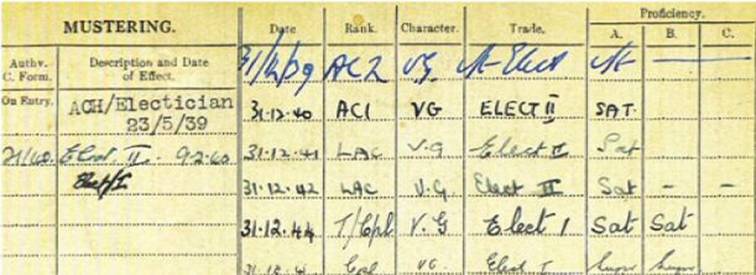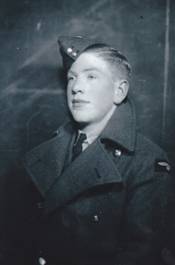 Vic Oldridge (c1938)Vic was born in Shepherd's Bush, London in 1922. His family moved to Cowley, near Exeter in Devon when he was nine in August 1931. The difference between the hustle and bustle of London and the quiet countryside of Cowley was too much of a contrast for him. He did not like the country living and he found school to be dull, so he left at the earliest opportunity, the statutory age of 14. He took on various jobs including working as a gardener's boy, working in a W H Smith's kiosk on Exeter station and working in stores. At the time of his enlistment he was working as an assistant in Mr Drew's Union Road Stores, Exeter. In 1936 he joined the 4th Battalion of the Devonshire Regiment (Territorial Army) and spent two years with them. He couldn't wait to leave home in rural Devon, though. As soon as he was old enough and aged just seventeen and a quarter he joined the RAF on 23rd May 1939, just before the start of World War 2. He is pictured here shortly after receiving his uniform. At birth Vic's name was registered as Lucas Henry Victor Oldridge but for all his days he was known as Vic. His first sighting of his birth certificate was after he had applied to join the RAF. Having put his name on his application as Victor, and then having to present his birth certificate with his full names on it, he always considered it most embarrassing to be hauled out of the line and required to explain himself, in front of his new RAF colleagues, because his application form didn't match with his birth certificate. 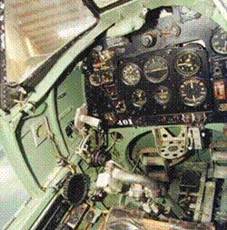 Spitfire cockpitVic was red/green colour blind, there was never any mistaking that. He had told his family, though, for many years that he wasn't colour blind despite the fact that he was diagnosed as such whilst with the RAF. Not until his grandson was confirmed as being colour blind, in the mid 1980s and long after Vic had retired, did he accept that he too was colour blind and that it wasn't just that, as he had always maintained, "he hadn't been taught his colours properly when he was a child". He became an electrician on aircraft, which seems odd considering that wiring was identified by colour in those days. For much of his service Vic was stationed in Malta, working as an electrician on various RAF aircraft including the Gloster Gladiator, the Hurricane and the Spitfire. Despite the permanent threat to the island and the hardships that everyone on the island suffered, it was this period of his service which he found most satisfying. His RAF service record is shown here; Vic's time in Malta is shown on a light gold background. The service record raised some questions for us and some of these have been resolved by Ross (aka "RAF Command") - see ww2talk.com forum. |
From |
To |
Location |
Duration |
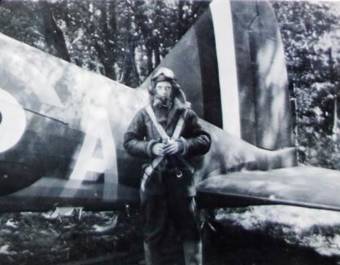 Vic about to take his |
From |
To |
Location |
 Vic 3 days into his service in MaltaThis tallies with the stories that Vic told us of his time in Malta. His photograph album tells us that he was an aircraft electrician and a member of 137 Maintenance Unit (137MU). He served in different locations on the island but his record shows that he was stationed at either Kalafrana or Hal-Far in south west Malta. Vic's photograph album also shows pictures he took whilst working at Tal-Handaq in the centre of the island. His first posting took him to Birzebuggia on the southern end of the island. He is shown here as a fresh faced callow youth, just three days after his arrival. The photograph album shows Vic developing into a young man. It shows the effects of the bombing, the places where he worked and how they spent their time when not servicing aircraft. As with most people on Malta during World War 2 there arose the opportunities for escapades. At one time Vic was 'missing, assumed killed' after a violent air raid on Malta. He had swapped his shift and headed for the beach with a pal. They saw the Italian aircraft fly over and took refuge in a cave. Vic later learned that his shift swap had not been properly recorded and he was listed as still being on base but had not reported in directly after the raid. For this reason he has been listed as "missing". 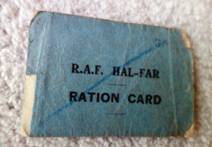 Vic's Ration CardOn another occasion he and a colleague were exploring some of the caves on the beach. Being unable to pick their way across the uneven surface in the dark the friend struck a match which lit up the cave just enough for them to see that it was a petrol dump and was the last place anybody should be lighting matches! Vic remarked some years later that they thought the cave had an aroma which was a bit like petrol. During a bombing raid by the Italian Air Force, Vic noticed that an anti-aircraft gun was standing in its emplacement, in the open and unmanned. Determined to do his bit he ran across a wide expanse of open ground to get to the gun so that he could at least get a shot or two at the raiders. It was only when he reached the gun that he found that there was no ammunition, which explained why it was unmanned. Rapidly retracing his steps to the safety of the bunker he shared with his colleagues he was welcomed by laughter and some good natured joshing. 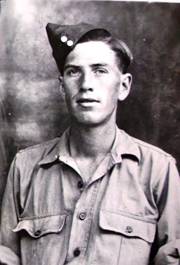 VicHis papers revealed a short period of time when he was sent to the RAF base at Tal-Handaq to work on some equipment there. Vic spent almost three years on Malta from September 1941 to August 1944. He returned to the United Kingdom and served in 8282 Serving Echelon for a year. This unit had been formed at Davidstow Moor on 1 February 1944 to service No 282 Squadron's Vickers Warwick aircraft before moving to St Eval on 19 September 1944 before being disbanded after Victory in Europe along with the squadron on 9 July 1945. From his Cornish posting Vic found it easy to take his leave with his family, who were living near Exeter, by taking a train from Camelford or Padstow. It was on one of these trips to Exeter that he first met his wife, Phyllis. Vic's final posting was to RAF Calshot where he worked on Short Sunderlands and the Catalina. Having worked on such a variety of aircraft as described above and others such as the Beaufort and the Lysander he maintained a real fondness for an aircraft he had never worked on. The First World War biplane the SE5A held a special place in his imagination which was only matched by the Spitfire and, later, the Brittania. In his time with the RAF he was promoted to Corporal, as can be seen below: |
|
|
|
|
Whilst he was serving on Malta, Vic's mother, Alice, was employed as a cleaner in a photographic studio in Exeter. The assistant in this studio was a young girl named Phyllis. Along with her mother and brother, Phyllis had been evacuated from Stanmore to the relative 'safety' of Exeter. Alice took a shine to Phyllis and encouraged her to write to Vic who, in Alice?s opinion, needed a pen pal. On one of his leave periods which we believe to be in late 1944, Alice engineered a meeting between 20 year old Vic and 16 year old Phyllis. Subsequently they met whenever he managed to return to Exeter on leave and they walked out together. At the time Phyllis was too young to go into pubs and had to wait outside whilst Vic went in to get himself a beer and for her, a soft drink. 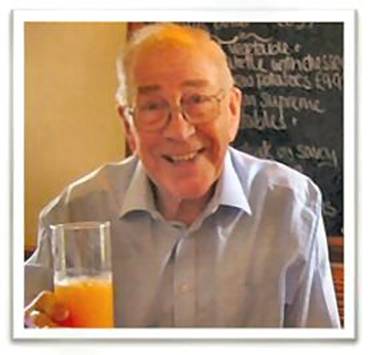 Vic was demobilised at Uxbridge in March 1946. He managed to get work, initially at Croydon Airport and then at Northolt. Phyllis had left Devon to return to Stanmore and married Vic there in 1947. They remained together until they both died in 2009 after 62 years of marriage. Following demobilisation he maintained his interest and contact with aircraft. He worked as an aircraft electrician for Handley Page, BEA, BOAC and BA at Croydon, Northolt and Heathrow. He worked on the electrical circuits in a variety of passenger aircraft including the Brittania and a wide range of Boeings. After 30 years with BOAC and British Airways, he retired to Hertfordshire where he passed his interest in aircraft onto his grandson, David. Vic enjoyed his time in the RAF and frequently remarked on this. He retained an interest in aircraft and the RAF throughout his life. He died in 2009 three weeks after being diagnosed with pancreatic cancer. He received the news in stoic fashion, saying he had had a 'bloody good life'. His ashes were scattered at RAF Duxford, partly on the large DX sign which can be seen from aircraft and partly under his favourite commercial aircraft, the very one he serviced when it flew with a BOAC livery, the Bristol 175 Britannia G-AOVT. |
